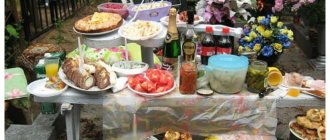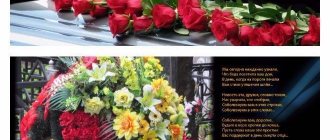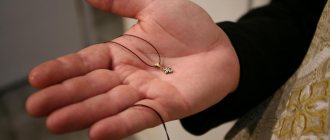All customs associated with burial and commemoration took shape over a long period of time. Some of them have an outdated, but rational justification, others are explained symbolically or are simply observed because it is customary.
No knives and forks
Often, as in old times, funeral feasts are eaten exclusively with spoons. This feature was formed for several reasons. One of them dates back to the times when only spoons were in use in the Slavic lands. The introduction of new cutlery - forks and knives - began under Peter the Great. These “devilish” pitchforks and blades were not accepted at all joyfully, often with active resistance to the foreign innovations of the “king-antichrist.” An echo of a long-standing confrontation is the refusal of knives and forks at the traditional funeral table.
In addition, in the old days, the division of inheritance began immediately after the funeral. All relatives, even the most distant ones, came to the wake. At the same time, a long-standing enmity could flare up, and knives, or even forks, inopportunely found at hand, would certainly lead to bloodshed.
The custom of holding a wake after a person’s funeral arose in ancient times.
Organization of funerals
Another explanation for the ban on knives and forks relates rather to the symbolic realm, to what is felt but not rationally interpreted. Ritual food is served at the funeral meal, which cannot be pierced or cut, so as not to disturb the deceased. In addition, kutya or volivka should be eaten with a spoon.
Signs
At home, before removing the body
From the first day of a person’s death until 40 days after it, all mirrors in the house and other reflective surfaces (TV, monitor) are covered with cloth, since the deceased can be reflected in them and take with him the soul of a living person looking at his reflection.
At the moment of death of a person, if his eyes remain open, it is necessary to lower the eyelids and apply coins to the eye sockets. There is a sign that a dead person lying in a coffin with his eyes half-open is “looking out for the soul” that he will take with him.
Before burial, while the deceased is in the house, prayers must be read to help his soul leave the body and ease its mental suffering. After washing his body, the deceased is dressed in the best festive clothes and light shoes (so that he can walk comfortably in the next world).
The water with which the deceased was washed should be poured into those places where literally “no human foot steps”, otherwise, if someone walks through the “dead” water, they may go to another world.
The coffin is placed on stools, which after removal they sit on, then they are turned over and placed on the floor with the seat facing down - this is necessary so that the soul of the deceased does not return . The deceased is placed in a coffin on a soft pillow and hands are folded on the chest so that the right is on top of the left, since they cross themselves with the right hand. A lit candle is placed nearby, which symbolizes the departure of the soul to a better world.
They carry out the deceased carefully so that the coffin does not hit the doorways, and always feet first, so that the soul does not return home. The coffin should be carried by acquaintances, neighbors or strangers, but in no case by blood relatives, since the deceased can take them with him.
After removing the body from the home, people who are not relatives of the deceased wash the floor from the corners to the threshold , thus washing away the traces so that the soul does not find the house and take other residents with it.
On the street near the house, the coffin is placed on stools, where close people take turns saying goodbye to the deceased, asking him for forgiveness and kissing him on the forehead, then the coffin lid is closed and the procession goes to the cemetery.
When a priest performs a funeral service for a deceased person, you must either be in the room where the sacrament is being performed, or go to another room; peeking from behind the door is prohibited. If a candle goes out in your hand during the sacrament, this may mean that the soul requires an offering of forgiveness from this person, or, on the contrary, asks him for it.
At the cemetery
After everyone arrives at the cemetery, the first to get out of the vehicle are people (not relatives) who carry the coffin out of the car, then blood relatives. A few coins are thrown into the dug grave, paying tribute to the earth so that it will accept a new body.
Before burial, a farewell speech is made over the deceased, and his body is lowered into the grave. Then, starting with close relatives, everyone in turn throws a handful of earth into the grave, thereby releasing the person and saying goodbye to him forever. If someone accidentally falls into a grave, he should immediately contact a priest after the funeral, otherwise, according to legend, he will die within 40 days .
The burial place chosen is small: exactly as much as is needed for 1 grave, so as not to bring trouble to relatives. Many people purchase a plot of land “with a reserve”, especially spouses, so that after death they “lie” in one place. Thus, they prophesy a quick death for themselves and their loved ones.
It is allowed to install either a cross (preferably) or a monument with a photograph of the deceased on the grave, since the simultaneous presence of both attributes is contrary to church rules. You should not choose a monument that is too heavy, otherwise it will be difficult for the deceased to lie down.
If other relatives and friends are already buried in the cemetery, there is no need to visit them on this day so that the soul of the deceased is not offended. After the burial, everyone present leaves for the memorial service, without looking back, so as not to return to the cemetery in the near future.
Alcohol and the funeral meal
Alcoholic drinks at funerals are not approved by the church. Wine in religious tradition symbolizes the joy of life and is inappropriate when saying goodbye to the deceased. In addition, drunkenness is interpreted as demonic possession, and a person who condones demons cannot ask for forgiveness of the sins of the deceased. Therefore, it is better to place a glass of water and a piece of bread near the portrait of the deceased. You can’t even drink this water and give this bread to animals.
Despite these considerations, there is still a custom of pouring vodka into a glass for the deceased, drinking at least one glass at the funeral for the repose of the soul, not clinking glasses, and accompanying the entire funeral meal with alcohol. Here you can see echoes of ancient and violent pagan funeral feasts, find reasons in established civil traditions and explain the use of alcohol with its antidepressant properties, which, however, are accompanied by harmful side effects.
What ingredients are they made from?
The most common version of the dish is made from rice and sweet raisins. Berries and fruits are added to add flavor. Funeral sweet porridge is served in small bowls at the edges of the table so that guests can easily reach the tribute.
Kutia is made from several ingredients:
- Wheat. Today you can buy refined grains in a store or on the market. There are special ready-made mixtures for funeral porridge. In the old days, the ritual of peeling cereals was a tradition. The grains for kutya were poured into clay makitra and gradually ground with a wooden mortar. The procedure was carried out exclusively by the owner of the house. To purchase a quality product, pay attention to the humidity level. You can check this indicator by cutting the grain in half. A dry ingredient will crack; a wet ingredient will squash.
- Honey. Professional chefs recommend buckwheat variety. The bee product has a beneficial effect on the formation of blood flow in the body, which affects the maintenance of optimal hemoglobin levels. Linden honey is effective for colds.
- Poppy. You can buy the herbal product in pre-packaged bags. Before adding the ingredient to the funeral kutya, you need to grind it in a mortar.
- Walnuts are sold in or without shells. Give preference to a light-colored core. Unpeeled nuts may become moldy or dry out over time.
- Raisins are chosen to taste. Light varieties are considered the best. The ingredient is first soaked in boiling water.
Need expert advice?
Get expert advice online. Ask your question right now!
Ask a free question View all questions
Before purchasing honey for preparing funeral traditional kutia, pay attention to the presence of impurities in it. To test, dissolve 100 g of bee product in a glass of water. Add some iodine. The formation of a blue tint indicates that the honey is unnatural. Some beekeepers use chalk to thicken the natural product. The presence of a mineral is easy to determine. Sprinkle regular vinegar onto the sweet substance. If there is a hissing sound, it means chalk has been added.
Modern cooks add different varieties of nuts, dried fruits and candied fruits to kutia. Funeral porridge should be rich in a variety of ingredients.
Food from the funeral table
It is customary to prepare a large funeral meal in order to feed as many people as possible in the name of the blessed memory of the deceased. Therefore, food from the funeral table is often given to the participants of the meal. If a relative or loved one brings food from the funeral table, household members should not be afraid of it. It was prepared for good purposes and will only bring benefits.
True, there are certain precautions that are recommended for guests at a wake. Even taking into account the general beneficial message, food from the funeral table should not be accepted from a hostile person. Those who practice household magic can take this opportunity to cast a food spell for a variety of selfish purposes.
Another rule applies: the leftovers after the feast at the wake are not thrown away, but given to animals.
What not to do
- When the deceased is in the house, he cannot be left alone in the room; there must be someone next to him to help his soul get rid of fear.
- Women during menstruation should not wash the body of the deceased, so as not to defile it with their uncleanness.
- Under no circumstances should the deceased be dressed in clothing that belongs to other people, since along with someone else’s clothing, the deceased may take his life with him.
- A pregnant woman should not touch the coffin or go to the cemetery, otherwise she may lose the child.
- If a person has died of cancer, relatives are not allowed to kiss him on the forehead (only the crown is allowed), so as not to incur the same misfortune on themselves.
- You cannot put the deceased in a coffin that is not the right size, thereby leaving room for the next deceased.
- While the deceased is at home, the cat should be removed from the home, as it can bring trouble.
- You cannot bury your spouse with a wedding ring on their finger, otherwise they will soon be united in the next world.
- While the deceased is in the house, you cannot clean or take out the trash, as the soul may “think” that it is being kicked out.
- All things that were bought for the deceased and were not used, as well as other attributes for the funeral (soap, towels that were used to greet guests from the cemetery) are prohibited from being left in the house; they must be burned or buried.
- You cannot walk in front of the coffin, or cross the path of the funeral procession; in this way, a person shows nature that he is “in a hurry” to the next world.
- Raising flowers after a funeral procession means taking the trouble upon yourself.
- If any thing falls to the ground in the churchyard, it should not be picked up, but should be left in the same place.
- After removing the deceased, you cannot return home for a forgotten item.
- For a funeral, each person needs to come to the deceased’s home from their home, without stopping anywhere along the way. Afterwards, only leave home, without stopping by for a visit, otherwise you will bring trouble to someone else’s house.
- For 40 days, you cannot lend money, food, etc. And also give away things, books, CDs and other household items.
- The burial cannot be carried out after sunset, otherwise the soul will not have time to get to the other world.
- photographs or personal items of other people in the coffin There are cases when a man put his cigarette case in a friend’s coffin “as a keepsake”; three years later he died from a long illness. In another family, a deceased grandmother was given a pacifier for her little granddaughter, after which the child began to have problems with speech, and for 5 years she could not speak.
All signs have sacred meaning and come from the rituals of the ancient Slavs. However, clergy appeal to the human mind to be skeptical about all signs, and to focus on prayers for the deceased, which are necessary to cleanse his soul and get it to heaven, since a funeral is a person’s farewell to eternal life.
Should pregnant women go to funerals?
Funerals and wakes, as their continuation, should not be attended by pregnant women. It is difficult to find a rational and obvious explanation for this, but the inappropriateness of the presence of a woman carrying a child in an atmosphere of grief, sadness and mourning is clearly felt intuitively. The farewell ceremony may require the obligatory presence of the pregnant woman, but staying in the cemetery, attending the burial and participating in the funeral meal can and should even be refused.
The Church does not impose such prohibitions, but, on the other hand, it does not oblige pregnant women to attend funerals and wakes. Instead of a cemetery and a meal, you can visit a temple, leave a memorial note, light a candle in memory of the deceased.
Recipe for rice kutya with almonds and raisins
- 100 gr. rice;
- 400 ml. water;
- 100 gr. raisins;
- 3 tbsp. l. honey;
- Candied fruits to taste;
- 50 g almonds.
Rinse the rice with water seven times. Pour it into a saucepan, add water according to the recipe, add a little salt, and cook until tender. When the rice is ready, you can pour cool water over it to keep it fluffy. Pour the cooled rice into a bowl and add raisins, which are pre-steamed for 20 minutes with boiling water and dried. After that, pour honey into the rice with raisins and gently knead. Decorate the finished porridge with almonds and candied fruits of your choice.
Cooking such kutia is a delicate matter, but not difficult. You can boil the cereal yourself for the holiday meal without any problems, and the rice will come out beautiful, crumbly and very tasty.
Let's work together to make the unique material even better, and after reading it, we ask you to repost it on a social network convenient for you. net.
Other beliefs associated with funerals
At the funeral table they say only good things about the deceased. This rule is thousands of years old, and people still try to follow it.
Before the funeral meal, you should definitely wash your hands thoroughly, meaning not only physical, but also energetic cleansing of the negative energy that accompanies the burial site.
A wake is not a place for strong emotions. For centuries, the prevailing signs say: whoever cries a lot drowns the deceased in tears. Whoever starts laughing will then shed a lot of tears
The complex of funeral superstitions forms a kind of cultural code, so that funeral services with kutya and spoons, drinks and water for the deceased can be immediately identified as domestic.
Rice colivo
Since rice kutia is most often prepared for funerals, you can find a huge number of recipes for its preparation. We'll look at another one.
Ingredients: four spoons of poppy seeds, fifty grams of light and dark raisins, three spoons of honey, one glass of long grain rice, fifty grams of dried cranberries, one glass of walnuts, one spoon of olive oil.
Before preparing the funeral kutya, the rice is washed seven times, water is poured at the rate of one to two, a pinch of salt and olive oil are added and cooked under a closed lid until tender over low heat. The finished porridge is cooled. Meanwhile, boil water. The raisins are sorted, washed and poured with boiling water. The cranberries are sorted, washed and placed on a napkin. The nuts are poured into a hot frying pan (can be heated in the microwave). The poppy seeds are ground with one spoon of sugar in a mortar. Prepared rice is seasoned with honey, nuts, cranberries, and poppy seeds. The finished dish is placed in a heap on a dish and decorated at your discretion, using nuts, cranberries, and so on.
Question and answer
Is there a church ban on the use of knives and forks at a funeral meal?
No, the church allows the use of both a knife and a fork during the funeral meal.
So, how to conduct a wake - with or without alcohol?
Here you need to make a responsible and conscious choice, taking into account who exactly will be present at the funeral table. If the relatives and friends of the deceased generally follow the prevailing civil tradition, then it is unlikely that they will be able to do without alcohol, at least in symbolic doses. If religious people gather to remember the deceased, following the commandments “blessed are the meek, for they will inherit the earth,” the non-alcoholic option will be the best.
How to make rice kutya with honey and nuts at home
Cooking such kutia is a delicate matter, but not difficult. You can boil the cereal yourself for the holiday meal without any problems, and the rice will come out beautiful, crumbly and very tasty.
We will take natural honey from the sweet ingredients, walnuts from the decoration elements, and cinnamon from the spices, so that not only the taste will be special, but also the taste will be appetizing.
Ingredients
- Long grain rice – 1 cup. (200 g);
- Walnuts (without shell) – 100 g;
- Honey – 2-3 tbsp. l.;
- Raisins of dark and light varieties (seedless) – 100 g;
- Powdered sugar – 1 tbsp. l.;
- Cinnamon – 1/3 tsp;
- Regular sugar - to taste.
Cooking homemade kutya with rice, raisins, honey and nuts step by step
- Rice must be washed, so first of all, wash it thoroughly, changing not a single portion of water.
- Then pour it into a saucepan, add boiling water and cook until tender. This may take on average 15-20 minutes.
It will be possible to boil rice especially quickly if you soak it in water in advance: this will make it more pliable, and therefore cook much faster.
- We also wash the raisins, pour them into boiling water, bring it to a boil, then place in a colander and leave for a while to drain the liquid.
- When the rice is cooked, transfer it to a plate, pour in fragrant honey, flavor with aromatic cinnamon and mix everything thoroughly. If you wish, you can add 1-2 tbsp here. l. regular sugar, but it will be no less sweet without it.
- We sort through our nuts, pour them into a plate with juice, and then mix everything together with raisins swollen in boiling water. Sprinkle the kutya with powdered sugar - and the treat can be served on the festive table.
Why you shouldn't leave food on graves
The tradition of remembering deceased relatives has deep roots. However, not all people know how to behave correctly at the resting place of the deceased.
Nowadays, many people take food with them to the cemetery to have a meal on the “bones of the deceased.” This cannot be done. Also, you should not leave food on the graves, because the deceased has already passed from the world of the living to the afterlife (incorporeal) and, accordingly, he does not need food.
In addition, you should not leave food on graves in order to maintain cleanliness in cemeteries. When you come to the resting place of a loved one, you can clean it up, lay fresh flowers, read a prayer, but do not litter the grave with food. After all, animals (stray dogs, foxes) can come to the smell of food and cause damage in a holy place.











